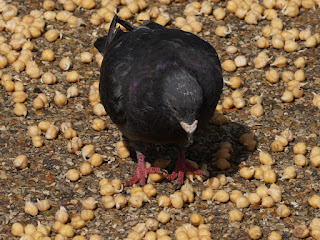The Little Owl at the Serpentine Gallery was in the same big horse chestnut tree as yesterday, though she was hiding in the leaves.
Cetti's Warblers also hide and are extremely hard to see. Usually you just hear them singing, and there may be a brief brown flash as one speeds from one bit of cover to another. But today I saw a beady little eye looking at me from the inside of a bramble patch, and got some kind of a picture before the bird retreated.
A Robin the the Flower Walk was also lurking in the shadows.
A Mistle Thrush poked its head out of a rowan tree on Buck Hill to pick a fruit.
A Starling swallowed a blackberry.
A young Grey Wagtail stood and stretched at the bottom of the Dell waterfall. They are particularly fond of running water -- unlike Pied Wagtails, which are quite happy on grass as long as there is a bit of water to drink somewhere.
A Carrion Crow dunked a chip in the pool at the top of the waterfall. They like their chips soggy.
Someone had scattered a lot of chickpeas at Peter Pan. The Feral Pigeons didn't quite know what to make of these unfamiliar things, but after a bit of examination decided they were edible.
The Hobbies came over the Long Water. One went off in the direction of the Round Pond and the other went back to the greenhouses.
The young Grey Herons had returned to their nest. I don't think their parents are feeding them any more.
A Herring Gull helped to clean the bottom of a pedalo which had been hauled on to the boat platform. It's good to see them making themselves useful.
Three Cormorants stood on the raft in the Long Water.
The two youngest Great Crested Grebe chicks were in the care of a parent.
A Moorhen stretched on a rail in the Italian Garden. The chicks were hidden in the reeds.
The oldest of the teenage Mute Swans are now capable of flight, but I still haven't seen one trying to get off the water. Thanks to Mark Williams for this picture of their subtle colours.
A very small mushroom came up on the edge of the Italian Garden. I think it's a Yellow Fieldcap, a short-lived thing that comes up in the early morning, bright yellow in colour, but quickly fades and withers by the end of the day.
This year's Serpentine pavilion was designed by a South African architect, Sumayya Vally, and today there were some South African musicians to provide entertainment. It makes a pleasant change from the 'sonic landscape' of recorded London noises usually played there, which is often downright creepy.















Latest news video of a young swan being rescued here. Jim
ReplyDeleteThanks for the link. Good girl.
DeleteBrilliant. She looks like she's handled large water fowl before.
DeleteLove the photo of the Cetti's just peaking out from the vegetation-more than I often see of them. I seem to have lost the one local bird which I had as I often heard it singing.
ReplyDeleteA great crop of Rowan berries-the Mistle Thrush shouldn't go hungry for a while.
That's a resident Mistle Thrush, one of a few. The migrant thrushes, when they arrive, will make short work of those attractive red fruits.
DeleteI agree about the wonderful picture of the Cetti's. Major props to Ralph!
ReplyDeleteI wish gulls persuaded themselves to be forces for good. They are great forces for evil, so perhaps they'd enjoy taking a view from the other side.
I think that even St Francis would have had serious difficulty in converting Herring Gulls.
Delete